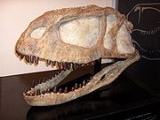
Abelisaur
Encyclopedia
Abelisaurs were a group of ceratosauria
n dinosaur
s which lived in the Southern hemisphere
(with the exception of Tarascosaurus
in Southern Europe
) during the Cretaceous
period. Some well-known dinosaurs of this group include Abelisaurus
, Carnotaurus
, and Majungasaurus
. They are known for their small arms. Some members had ornamented heads, such as Carnotaurus and Majungasaurus; the horns and knobs may have been used for display.
Ceratosauria
Ceratosaurs are members of a group of theropod dinosaurs defined as all theropods sharing a more recent common ancestry with Ceratosaurus than with birds. There is presently no universally agreed upon listing of species or diagnostic characters of Ceratosauria, though they were less derived...
n dinosaur
Dinosaur
Dinosaurs are a diverse group of animals of the clade and superorder Dinosauria. They were the dominant terrestrial vertebrates for over 160 million years, from the late Triassic period until the end of the Cretaceous , when the Cretaceous–Paleogene extinction event led to the extinction of...
s which lived in the Southern hemisphere
Southern Hemisphere
The Southern Hemisphere is the part of Earth that lies south of the equator. The word hemisphere literally means 'half ball' or "half sphere"...
(with the exception of Tarascosaurus
Tarascosaurus
Tarascosaurus is a genus of, perhaps abelisaurid, theropod dinosaur from Late Cretaceous of France.After having in 1988 identified an upper jaw bone found near Pourcieux as belonging to a member of the Abelisauridae, French paleontologist Eric Buffetaut reviewed the known remains of larger...
in Southern Europe
Europe
Europe is, by convention, one of the world's seven continents. Comprising the westernmost peninsula of Eurasia, Europe is generally 'divided' from Asia to its east by the watershed divides of the Ural and Caucasus Mountains, the Ural River, the Caspian and Black Seas, and the waterways connecting...
) during the Cretaceous
Cretaceous
The Cretaceous , derived from the Latin "creta" , usually abbreviated K for its German translation Kreide , is a geologic period and system from circa to million years ago. In the geologic timescale, the Cretaceous follows the Jurassic period and is followed by the Paleogene period of the...
period. Some well-known dinosaurs of this group include Abelisaurus
Abelisaurus
Abelisaurus is a genus of abelisaurid theropod dinosaur from the Late Cretaceous Period of what is now South America. It was a bipedal carnivore that probably reached 7 to 9 meters in length, although it is known from only one partial skull.The generic name recognizes Roberto Abel as the...
, Carnotaurus
Carnotaurus
Carnotaurus was a large predatory dinosaur. Only one species, Carnotaurus sastrei has been described so far.Carnotaurus lived in Patagonia, Argentina during the Campanian or Maastrichtian stage of the Late Cretaceous...
, and Majungasaurus
Majungasaurus
Majungasaurus is a genus of abelisaurid theropod dinosaur that lived in Madagascar from 70 to 65.5 million years ago, at the end of the Cretaceous Period. Only one species has been identified...
. They are known for their small arms. Some members had ornamented heads, such as Carnotaurus and Majungasaurus; the horns and knobs may have been used for display.
Classification
- Superfamily Abelisauroidea
- AustrocheirusAustrocheirusAustrocheirus is an extinct genus of neoceratosaurian theropod dinosaur which existed during the late Cretaceous period. It was named and described by Martín Ezcurra, Federico Agnolin and Fernando Novas in 2010. It contains the type species Austrocheirus isasii. The generic name means "southern hand"...
- GenusaurusGenusaurusGenusaurus is a genus of dinosaur from the Early Cretaceous. Its fossils were found in France. Scientists have estimated the length of Genusaurus to have been 3 m and its weight 50 kg...
- LigabueinoLigabueinoLigabueino is a genus of noasaurid dinosaur named after Italian doctor Giancario Ligabue. It is known only from an extremely fragmentary specimen, measuring 70 cm long. In spite of initial reports that it was an adult, the unfused vertebrae indicate that the specimen was a juvenile...
- OzraptorOzraptorOzraptor is an abelisauroid theropod dinosaur from the Middle Jurassic Colalura Sandstone of Australia.In 1967 a group of four twelve-year-old Scotch College schoolboys found a fossil at the Bringo Railway Cutting site near Geraldton, which they showed to Professor Rex Prider of the University of...
- TarascosaurusTarascosaurusTarascosaurus is a genus of, perhaps abelisaurid, theropod dinosaur from Late Cretaceous of France.After having in 1988 identified an upper jaw bone found near Pourcieux as belonging to a member of the Abelisauridae, French paleontologist Eric Buffetaut reviewed the known remains of larger...
- Family NoasauridaeNoasauridaeNoasaurids were a group of theropod dinosaurs from the Cretaceous Period . They were generally small in size...
- LaevisuchusLaevisuchusLaevisuchus is a genus of abelisauroid theropod dinosaur from the Late Cretaceous.Its remains were discovered by Charles Alfred Matley near Jabalpur in Maastrichtian deposits in the Lameta Formation in India, and named and described by paleontologists Friedrich von Huene and Matley in 1933. The...
- MasiakasaurusMasiakasaurusMasiakasaurus was a small predatory theropod dinosaur from the Late Cretaceous of Madagascar. It was named in 2001 by Scott D. Sampson, Matthew Carrano, and Catherine A. Forster. Unlike most theropods, the front teeth of Masiakasaurus projected forward instead of straight down...
- NoasaurusNoasaurusNoasaurus is the name given to a carnivorous dinosaur genus of the late Campanian-Maastrichtian...
- VelocisaurusVelocisaurusVelocisaurus is a genus of ceratosaurian theropod dinosaur from the Cretaceous period of Argentina.In 1985 Oscar de Ferrariis and Zulma Gasparini uncovered fossils at Boca del Sapo in Neuquén province of Patagonia from layers of the Bajo de la Carpa Formation, dating from the Santonian. Among them...
- Laevisuchus
- Family AbelisauridaeAbelisauridaeAbelisauridae is a family of ceratosaurian theropod dinosaurs. Abelisaurids thrived during the Cretaceous Period, on the ancient southern supercontinent of Gondwana, and today their fossil remains are found on the modern continents of Africa and South America, as well as on the Indian...
- Austrocheirus

